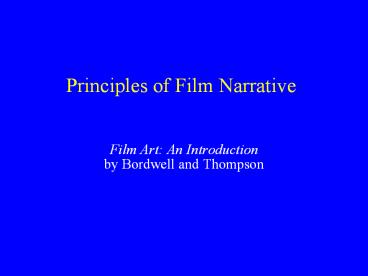Principles of Film Narrative Film Art: An Introduction by - PowerPoint PPT Presentation
1 / 18
Title:
Principles of Film Narrative Film Art: An Introduction by
Description:
Principles of Film Narrative Film Art: An Introduction by Bordwell and Thompson What is Narrative? How a film tells a story by organizing information. chain of ... – PowerPoint PPT presentation
Number of Views:600
Avg rating:3.0/5.0
Title: Principles of Film Narrative Film Art: An Introduction by
1
Principles of Film Narrative
- Film Art An Introduction
- by Bordwell and Thompson
2
What is Narrative?
- How a film tells a story by organizing
information. - chain of events in cause-effect (causality)
relationship occurring in time and space. - We understand narrative by associating events
with cause-effect, time, space.
3
Plot and Story
- Viewer also makes assumptions or inferences about
events not explicitly presented. - All events in the narrative--explicit and
inferred by viewer--comprise the story. - Northwest by Northwest traffic, city, office
environment suggests character (Thornhill) leads
a busy life.
4
Plot and Story (cont.)
- Plot totality of the film.
- Everything presented visibly and audibly
- Story events directly depicted.
- Extraneous (implied) material that adds to story
5
Plot and Story (cont.)
- Plot and Story overlap
- Story exceeds plot by bringing in inferred
information never actually seen. - Plot exceeds story by presenting images or sounds
from outside story that affect understanding of
the story.
6
Story and Plot (cont.)
Story
Plot
Presumed and inferred events
Explicitly presented events
Extraneous material from outside story
7
Plot and Story (cont.)
- Story includes all events in the narrative
- Filmmaker can present events directly (part of
plot), suggest or infer events not explicitly
presented, ignore certain events altogether, or
add extraneous material.
8
Plot and Story (cont.)
- Audience views only the plot, arrangement of
material in the film as it stands, and creates
story from cues in the plot. - Distinction between plot and story constitutes a
set of tools for analyzing how narrative works.
9
Cause and Effect
- Characters usually initiate cause-effect by
triggering or reacting to events. - Character traits play causal role in narrative
- Attitudes, skills, emotion, tastes, appearance
- e.g., Shawshank shows Andy as reserved banker,
serves narrative function
10
Cause and Effect (con.t)
- Incidences can also trigger cause-effect, and
human action develops narrative. - e.g., earthquake, drought, flood, economy.
- Viewer connects events by cause-effect, inferring
what caused it and possible responses.
11
Cause and Effect (con.t)Example of a Detective
Film
a. Crime conceived
b. Crime planned
c. Crime committed
Story
d. Crime discovered
Plot
e. Detective investigated
f. Detective reveals a, b, c
12
Time
- Events take place in time, in chronological order
or not, for effect. - Most plots do not show every detail of time.
13
Space
- Events in narrative occur in certain places.
- Typically the same for the story action and plot,
but plot can make us infer other places that
contribute to the story. - Screen duration (between frames) also selects
plot spans for presentations.
14
Narration The Flow of Story Information
- Narration is plots way to provide information to
achieve specific effects. - Moment-by-moment process that guides us in
building the story out of the plot. - Plot may supply information to create
expectations or suspense, or arrange cues that
withhold information to build curiosity or
surprise.
15
Film Genre
- Film Art An Introduction
- by Bardwell and Thompson
16
Defining a Genre
- Types of films
- Musical, thriller, comedy, western, science
fiction,... - No clear distinction about what makes a groups of
films a genre. - Genre helps assure some general notions about
films.
17
Analyzing Genre
- A genre may share certain plot elements.
- e.g., investigation in a mystery, revenge in
Westerns, gangster film and price of crime... - Genre conventions give viewer insight into film
- Allows information to be communicated quickly
- Rejecting conventions can also add surprise or
shock to viewers. - Genres change over time, and originate from
combining qualities of different genres.
18
Summarizing Genre
- Genres comprise some aspects of a film that we
take for granted. - Genre categories can shape what we expect to see
and hear, and to understand a film in certain
ways.












![Introduction to Biopsychology [PSB 4002] PowerPoint PPT Presentation](https://s3.amazonaws.com/images.powershow.com/6377876.th0.jpg?_=20150404023)


















